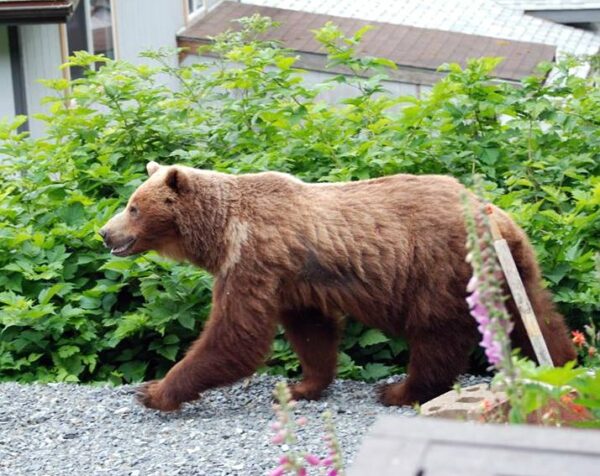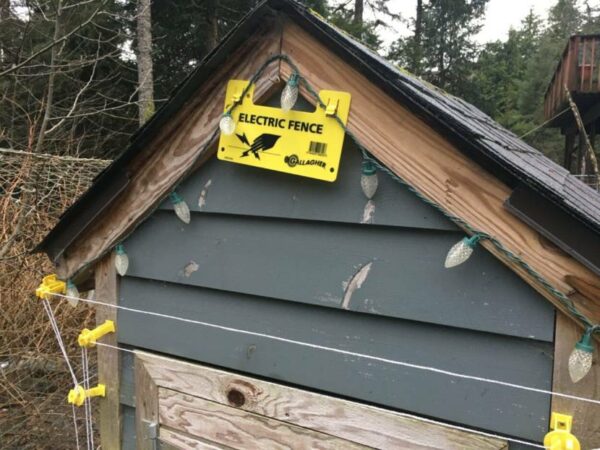
As Sitka’s deadliest bear season in recent memory winds down, the Department of Fish & Game is stepping up outreach to try and prevent a repeat of 2021, when 14 brown bears were killed in the community.
Fish and Game biologist Steve Bethune says he spends a lot of time talking to concerned humans about bears.
“I deal with some real extreme attitudes about bears here in town,” Bethune said at a mid-November presentation on living with bears. “There’s kind of a ‘kill ’em all’ crowd, and there’s the ‘they were here first’ crowd. And I try to get everybody more where I live — more in the center.”
Bethune spoke to an in-person and online audience in Sitka’s Harrigan Centennial Hall. Just as he can’t kill every bear that enters town, Bethune said, he must kill some that are a legitimate threat to public safety.
He said he doesn’t use the term “problem bear” because he believes bears aren’t the problem.
“Because they’re just bears being bears,” said Bethune. “It’s actually people that are the problem. And the bears are using the intelligence that they’ve been created with, and all their resources, and they have to do the best they can with whatever they can just to survive.”
Bethune said that bears come into contact with humans because humans provide them with a limitless supply of high-calorie food. A domestic chicken has about as many calories as a salmon. A greasy pizza box is also rich in calories. Even with about a dozen bears killed in the Sitka area this year, he said “the calls keep rolling in.”
The exact number of bears in Sitka is elusive because their sense of smell is legendary — 10 times better than a bloodhound’s, 2,500 times better than human’s. Also, they travel far. Today’s Sitka bear might have been far away yesterday.
“Moving long distances for these bears is really, really common — up to 50 miles a day is not unheard of,” Bethune said. “And we know from radio collar data that they’re excellent swimmers. Even here in town, you know, the bears are using all the little islands, and then there’s Middle Island, Kasiana Island, Apple Island. We’ve had a bear over on Japonski Island, and I’m pretty sure they’re not walking across the bridge.”
This mobility is why relocating bears isn’t feasible, he said. Many of the complaints Bethune receives involve his decision to kill a bear rather than trap and move it to a far-off island. Short answer, he said: It doesn’t work.
“Bears have a tremendous homing instinct,” he said. “And over and over and over our radio collar data shows these bears covering tremendous distances and large bodies of water to get back to where they are removed from.”
Bethune said a bear that doesn’t make it back to its home range will likely come to harm. He likened it to a non-urbanite like himself being dropped into Times Square completely unprepared.
Although this has been the worst year for urban bear mortality in Sitka in the last 30 years, Bethune believes an answer has emerged recently that can help enormously: inexpensive electric fence kits. He said Fish and Game bought several at less that $300 that can be loaned to residents while they work on permanent solutions at their homes.

Bethune quoted a fellow biologist as saying that “what most people know about bears has more to do with the nature of bear stories than with the nature of bears.” He added that with bears, “we often see what we believe.”
He said the only effective way to eliminate bears from Sitka is to eliminate the reason they come to town.
“It’s unsecured garbage that’s a problem,’ said Bethune. “When I remove a bear, that is treating a symptom and not treating the root cause”
As for when bears will finally head into their dens for the winter, Bethune said there isn’t a precise date. Some sows with cubs might den up in October. For other bears, he said, “Thanksgiving is kind of a general standard.”
[Sign up for Alaska Public Media’s daily newsletter to get our top stories delivered to your inbox.]
Robert Woolsey is the news director at KCAW in Sitka.




